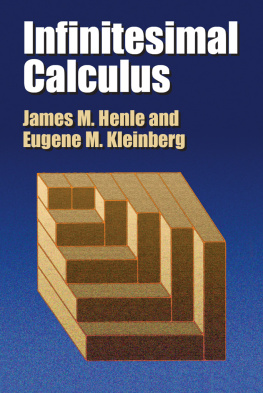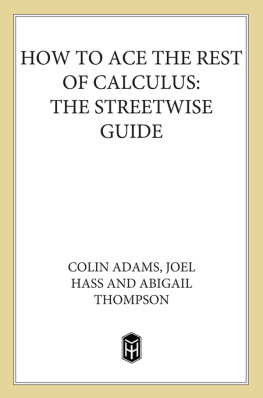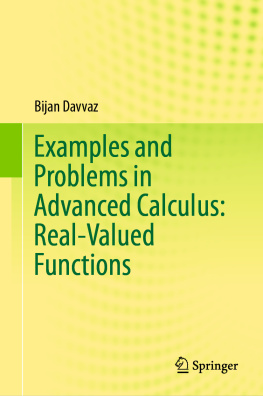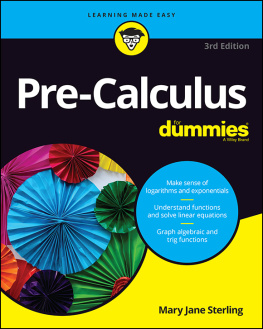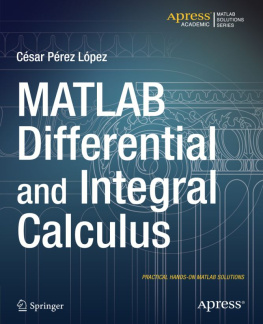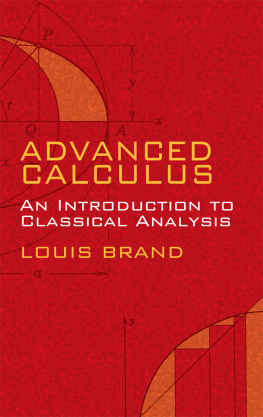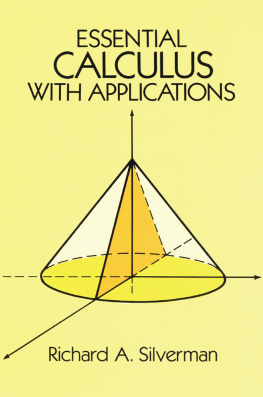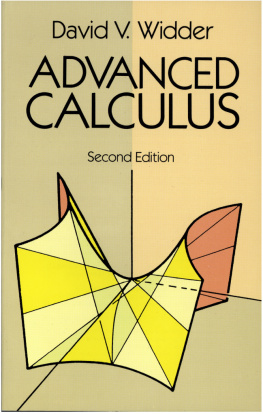James M. Henle - Infinitesimal Calculus
Here you can read online James M. Henle - Infinitesimal Calculus full text of the book (entire story) in english for free. Download pdf and epub, get meaning, cover and reviews about this ebook. year: 2003, publisher: Dover Publications, genre: Science. Description of the work, (preface) as well as reviews are available. Best literature library LitArk.com created for fans of good reading and offers a wide selection of genres:
Romance novel
Science fiction
Adventure
Detective
Science
History
Home and family
Prose
Art
Politics
Computer
Non-fiction
Religion
Business
Children
Humor
Choose a favorite category and find really read worthwhile books. Enjoy immersion in the world of imagination, feel the emotions of the characters or learn something new for yourself, make an fascinating discovery.
- Book:Infinitesimal Calculus
- Author:
- Publisher:Dover Publications
- Genre:
- Year:2003
- Rating:5 / 5
- Favourites:Add to favourites
- Your mark:
- 100
- 1
- 2
- 3
- 4
- 5
Infinitesimal Calculus: summary, description and annotation
We offer to read an annotation, description, summary or preface (depends on what the author of the book "Infinitesimal Calculus" wrote himself). If you haven't found the necessary information about the book — write in the comments, we will try to find it.
Infinitesimal Calculus — read online for free the complete book (whole text) full work
Below is the text of the book, divided by pages. System saving the place of the last page read, allows you to conveniently read the book "Infinitesimal Calculus" online for free, without having to search again every time where you left off. Put a bookmark, and you can go to the page where you finished reading at any time.
Font size:
Interval:
Bookmark:
INFINITESIMAL
CALCULUS JAMES M. HENLE
Department of Mathematics
Smith College EUGENE M. KLEINBERG
Department of Mathematics
State University of New York at Buffalo DOVER PUBLICATIONS, INC.
Mineola, New York Copyright Copyright 1979 by The Massachusetts Institute of Technology All rights reserved. Bibliographical Note This Dover edition, first published in 2003, is an unabridged republication of the work published by The MIT Press, Cambridge, MA, 1979. The publisher would like to thank The MIT Press for their assistance in the preparation of this edition. Library of Congress Cataloging-in-Publication Data Henle, James M.
Infinitesimal calculus / James M. Henle, Eugene M. Kleinberg.
p. cm. Originally published: Cambridge, Mass.: MIT Press, cl979. eISBN-13: 978-0-486-15101-4 1. Calculus. I. I.
Kleinberg, Eugene M. II. Title. QA303.2.H45 2003 515dc21 2003043991 Manufactured in the United States by Courier Corporation
42886904 2013
www.doverpublications.com to our parents ... we shall discover much Emptiness, Darkness and Confusion; nay, if I mistake not, direct impossibilities and contradictions. Whether this be the case or no, every thinking reader is entreated to examine and judge for himself...
George Berkeley, Bishop of Cloyne (16851753)
Instead we have settled into teaching specific methods for applying calculus in specific situations. The problem here, of course, is that even though individual methods might be fairly easy to master, there exist very many, seemingly distinct, methods to be learned, and even then most courses leave students hopelessly short. This active evolution in the teaching of calculus was always prompted by continual dissatisfaction with earlier approaches and had nothing to do with new mathematical insights into calculus itself. Indeed there were no such new insights; that is, there were none until just recently. In the early 1960s the mathematician Abraham Robinson pioneered a body of work known as Nonstandard Analysis which makes precise and mathematically rigorous the intuitively pleasing concept of infinitesimal. Originally Robinsons field was reserved as an advanced graduate subject, but the ideas are both simple and important, and in recent years everyone from standard mathematicians to economists, physicists, and social scientists have been using his methods with stunning success.
A most natural place for Robinsons insight is as a next (and possibly final) point in the evolution of the teaching of calculus. We can now develop calculus using infinitesimals and enjoy all of their simplicity and intuitive power, yet at the same time work in a mathematically precise and rigorous atmosphere. This approach, although quite new, has been used at a number of universities with remarkable success. This book presents a rigorous development of calculus using infinitesimals in the style of Robinson. It does not make any attempt to cover the assorted methods of calculus for applications, but rather it concentrates on theory, the area which previously was so difficult. We feel that with this new approach, basic theory is now quite accessible to studentseven those who are interested in calculus solely for its applications.
Indeed a knowledge of basic theory lets one dispense with learning many of the canned methods in favor of attacking problems directly and formulating ones own methods. The only prerequisite assumed for this book is a good foundation in high school mathematics. Our early chapters deal with the field of mathematical logic. Some of this is necessary for an understanding of infinitesimal calculus, but much of it is not. That which can be skipped is indicated in the text. We received help from a great many people during the preparation of this manuscript, much of it from students taking preliminary versions of the course.
Special thanks are also due to Professors Frank Wattenberg and David Schaffer, and to Mitchell Spector. Finally, Denise Borsuk typed countless versions of the text and displayed patience, good humor, and skill. To her we are most grateful. J. M. M. M.
Kleinberg
The methods it developed gave the physical sciences an impetus without parallel in history, for through them natural science was born, and without them physics could not have progressed much further than the mystical vortices of Descartes. In the beginning there were two calculi, the differential and the integral. The first had been developed to determine the slopes of tangents to certain curves, the second to determine the areas of certain regions bounded by curves. Algebra, geometry, and trigonometry were simply insufficient to solve general problems of this sort, and prior to the late seventeenth century mathematicians could at best handle only special cases. The general idea of the calculus, its fundamental theorem, and its first applications to the outstanding problems of mathematics and the natural sciences are due independently to Isaac Newton (16421727) and Gottfried Leibniz (16461716). Their work was certainly built on foundations laid by others, but their penetrating insights represented what is easily the most significant mathematical breakthrough since the Greeks.
Remarkably, the powerful methods developed by these two men solved the same class of problems and proved many of the same theorems yet were based on different theories. Newton thought in terms of limits whereas Leibniz thought in terms of infinitesimals, and although Newtons theory was formalized long before Leibnizs, it is far easier to work with Leibnizs techniques. The approach to the calculus we shall employ is based on Leibnizs ideas as formalized by Abraham Robinson in 1961 under the name of nonstandard analysis. Simply stated, our approach will involve expanding the real number system by introducing new numbers called infinitesimals. These new numbers will have the property that although different from 0, each is smaller than every positive real number and larger than every negative real number. Of course our infinitesimals cannot themselves be real numbers, but so what? This sort of expansion of a number system through the introduction of new numbers which themselves correspond to nothing in the real world is common in mathematics.
Next pageFont size:
Interval:
Bookmark:
Similar books «Infinitesimal Calculus»
Look at similar books to Infinitesimal Calculus. We have selected literature similar in name and meaning in the hope of providing readers with more options to find new, interesting, not yet read works.
Discussion, reviews of the book Infinitesimal Calculus and just readers' own opinions. Leave your comments, write what you think about the work, its meaning or the main characters. Specify what exactly you liked and what you didn't like, and why you think so.

